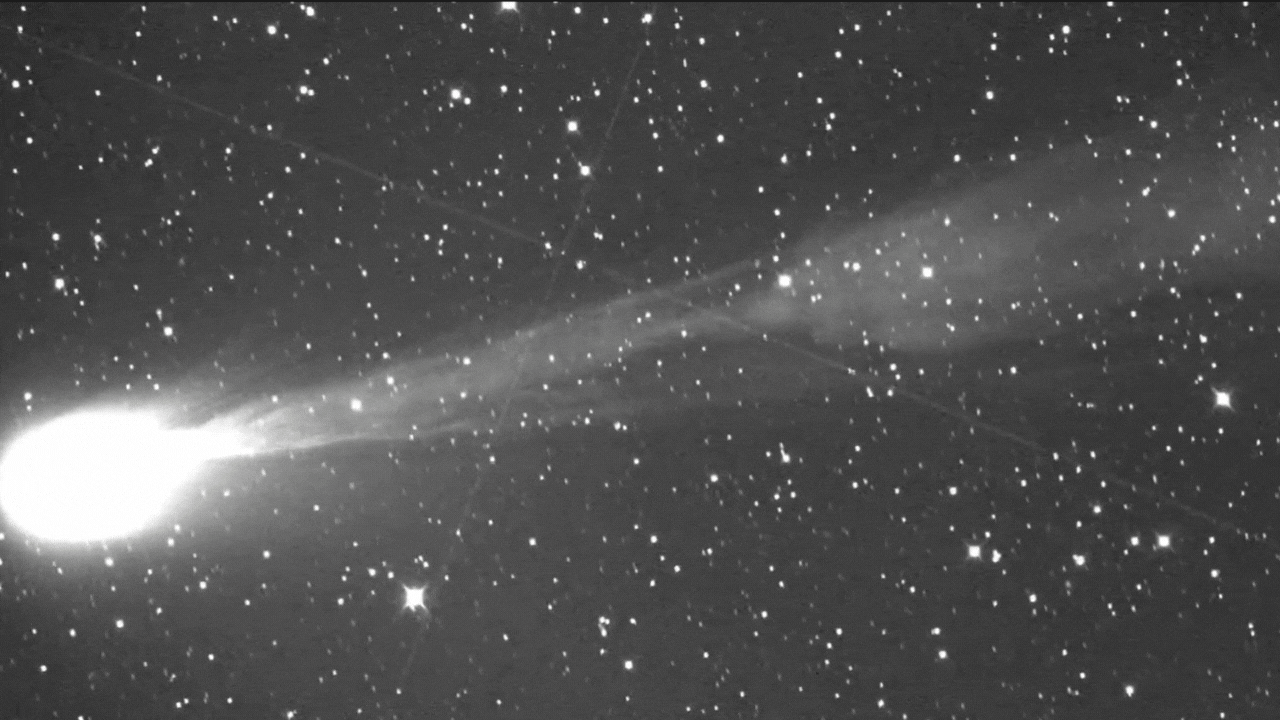
[ad_1]
The rare celestial event known as the “Devil Comet,” or Comet 12P/Pons-Brooks, is expected to align with the Great North American Total Solar Eclipse on April 8. This unique occurrence offers sky enthusiasts the thrilling possibility of capturing an exceptional celestial alignment. However, it remains uncertain whether the comet will be visible with the naked eye during the eclipse’s peak.
Comet 12P/Pons-Brooks, often described by the late Harvard astronomer Fred Whipple as a “dirty snowball,” is making its way through space, set to be nearest to the Sun on April 21 and closest to Earth by June 2.The comet’s increasing activity due to solar heating promises a fascinating view, particularly for those into astrophotography.
The comet’s enigmatic shape, which some have likened to the Millennium Falcon from “Star Wars,” remains a puzzle for scientists. Having an orbital period of 71.3 years, Pons-Brooks is not a frequent visitor. Identified as a Halley-type comet, it was first spotted in 1812 by Jean-Louis Pons and observed again in 1883 by William Robert Brooks. The comet’s nucleus spans approximately 20 miles (32 kilometers).
Recently, Pons-Brooks has shown significant activity, with Ariel Graykowski of the SETI institute noting, “The outburst…struck awe in all of us because it was so intense and produced a weird shape.” This activity has led to its nickname, the “Devil Comet,” due to its horn-like appearance after outbursts.
For those hoping to catch a glimpse of the comet, Graykowski advises that Pons-Brooks might become visible to the naked eye as it approaches perihelion, with an expected maximum brightness magnitude around 4.0. The comet is currently visible in the early evening within the Pisces constellation and might become even more luminous around perihelion if another significant outburst occurs, remaining visible until early May.
The total solar eclipse on April 8 may present a unique chance to see both the comet and the eclipse together, depending on local conditions and geography. While astrophotographers may have the opportunity to capture both celestial events in one frame, Graykowski cautions, “you will still need binoculars or a telescope, unless the comet ends up being brighter than current estimates.”
With its next visit anticipated in 2097, those missing Comet Pons-Brooks this time will have a long wait ahead. In the meantime, observers can marvel at the spectacle of the comet and the total solar eclipse, providing a unique moment in astronomical history.
As this comet makes its journey around the sun, its unique outbursts provide an exceptional opportunity for scientists to study its properties, including the mysterious ice patches on its surface and the effects of solar heat.
Comet 12P/Pons-Brooks, often described by the late Harvard astronomer Fred Whipple as a “dirty snowball,” is making its way through space, set to be nearest to the Sun on April 21 and closest to Earth by June 2.The comet’s increasing activity due to solar heating promises a fascinating view, particularly for those into astrophotography.
The comet’s enigmatic shape, which some have likened to the Millennium Falcon from “Star Wars,” remains a puzzle for scientists. Having an orbital period of 71.3 years, Pons-Brooks is not a frequent visitor. Identified as a Halley-type comet, it was first spotted in 1812 by Jean-Louis Pons and observed again in 1883 by William Robert Brooks. The comet’s nucleus spans approximately 20 miles (32 kilometers).
Recently, Pons-Brooks has shown significant activity, with Ariel Graykowski of the SETI institute noting, “The outburst…struck awe in all of us because it was so intense and produced a weird shape.” This activity has led to its nickname, the “Devil Comet,” due to its horn-like appearance after outbursts.
For those hoping to catch a glimpse of the comet, Graykowski advises that Pons-Brooks might become visible to the naked eye as it approaches perihelion, with an expected maximum brightness magnitude around 4.0. The comet is currently visible in the early evening within the Pisces constellation and might become even more luminous around perihelion if another significant outburst occurs, remaining visible until early May.
The total solar eclipse on April 8 may present a unique chance to see both the comet and the eclipse together, depending on local conditions and geography. While astrophotographers may have the opportunity to capture both celestial events in one frame, Graykowski cautions, “you will still need binoculars or a telescope, unless the comet ends up being brighter than current estimates.”
With its next visit anticipated in 2097, those missing Comet Pons-Brooks this time will have a long wait ahead. In the meantime, observers can marvel at the spectacle of the comet and the total solar eclipse, providing a unique moment in astronomical history.
As this comet makes its journey around the sun, its unique outbursts provide an exceptional opportunity for scientists to study its properties, including the mysterious ice patches on its surface and the effects of solar heat.
[ad_2]
Source link
